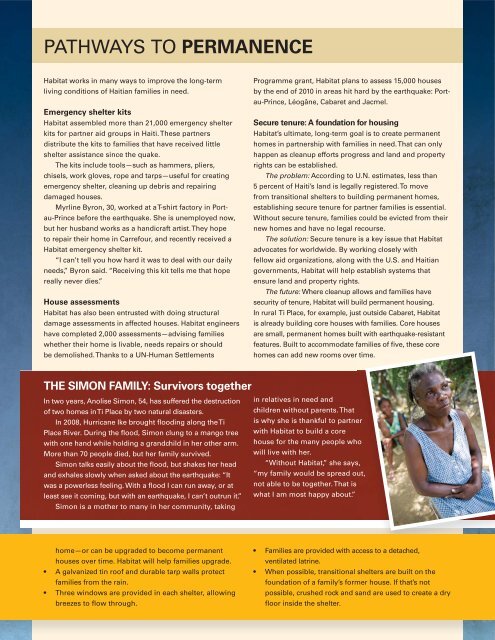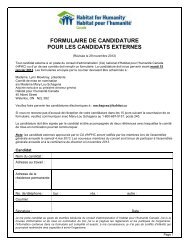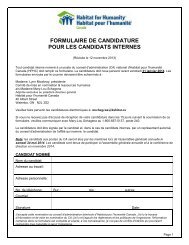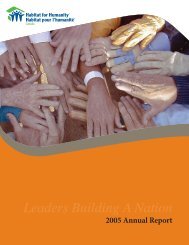PROGRESS IN HAITI
PROGRESS IN HAITI - Habitat for Humanity Canada
PROGRESS IN HAITI - Habitat for Humanity Canada
Create successful ePaper yourself
Turn your PDF publications into a flip-book with our unique Google optimized e-Paper software.
PATHWAYS TO PERMANENCE<br />
Habitat works in many ways to improve the long-term<br />
living conditions of Haitian families in need.<br />
Emergency shelter kits<br />
Habitat assembled more than 21,000 emergency shelter<br />
kits for partner aid groups in Haiti. These partners<br />
distribute the kits to families that have received little<br />
shelter assistance since the quake.<br />
The kits include tools—such as hammers, pliers,<br />
chisels, work gloves, rope and tarps—useful for creating<br />
emergency shelter, cleaning up debris and repairing<br />
damaged houses.<br />
Myrline Byron, 30, worked at a T-shirt factory in Portau-Prince<br />
before the earthquake. She is unemployed now,<br />
but her husband works as a handicraft artist. They hope<br />
to repair their home in Carrefour, and recently received a<br />
Habitat emergency shelter kit.<br />
“I can’t tell you how hard it was to deal with our daily<br />
needs,” Byron said. “Receiving this kit tells me that hope<br />
really never dies.”<br />
House assessments<br />
Habitat has also been entrusted with doing structural<br />
damage assessments in affected houses. Habitat engineers<br />
have completed 2,000 assessments—advising families<br />
whether their home is livable, needs repairs or should<br />
be demolished. Thanks to a UN-Human Settlements<br />
Programme grant, Habitat plans to assess 15,000 houses<br />
by the end of 2010 in areas hit hard by the earthquake: Portau-Prince,<br />
Léogâne, Cabaret and Jacmel.<br />
Secure tenure: A foundation for housing<br />
Habitat’s ultimate, long-term goal is to create permanent<br />
homes in partnership with families in need. That can only<br />
happen as cleanup efforts progress and land and property<br />
rights can be established.<br />
The problem: According to U.N. estimates, less than<br />
5 percent of Haiti’s land is legally registered. To move<br />
from transitional shelters to building permanent homes,<br />
establishing secure tenure for partner families is essential.<br />
Without secure tenure, families could be evicted from their<br />
new homes and have no legal recourse.<br />
The solution: Secure tenure is a key issue that Habitat<br />
advocates for worldwide. By working closely with<br />
fellow aid organizations, along with the U.S. and Haitian<br />
governments, Habitat will help establish systems that<br />
ensure land and property rights.<br />
The future: Where cleanup allows and families have<br />
security of tenure, Habitat will build permanent housing.<br />
In rural Ti Place, for example, just outside Cabaret, Habitat<br />
is already building core houses with families. Core houses<br />
are small, permanent homes built with earthquake-resistant<br />
features. Built to accommodate families of five, these core<br />
homes can add new rooms over time.<br />
THE SIMON FAMILY: Survivors together<br />
In two years, Anolise Simon, 54, has suffered the destruction<br />
of two homes in Ti Place by two natural disasters.<br />
In 2008, Hurricane Ike brought flooding along the Ti<br />
Place River. During the flood, Simon clung to a mango tree<br />
with one hand while holding a grandchild in her other arm.<br />
More than 70 people died, but her family survived.<br />
Simon talks easily about the flood, but shakes her head<br />
and exhales slowly when asked about the earthquake: “It<br />
was a powerless feeling. With a flood I can run away, or at<br />
least see it coming, but with an earthquake, I can’t outrun it.”<br />
Simon is a mother to many in her community, taking<br />
in relatives in need and<br />
children without parents. That<br />
is why she is thankful to partner<br />
with Habitat to build a core<br />
house for the many people who<br />
will live with her.<br />
“Without Habitat,” she says, s,<br />
“my family would be spread out,<br />
not able to be together. That is<br />
what I am most happy about.”<br />
home—or can be upgraded to become permanent<br />
houses over time. Habitat will help families upgrade.<br />
• A galvanized tin roof and durable tarp walls protect<br />
families from the rain.<br />
• Three windows are provided in each shelter, allowing<br />
breezes to flow through.<br />
• Families are provided with access to a detached,<br />
ventilated latrine.<br />
• When possible, transitional shelters are built on the<br />
foundation of a family’s former house. If that’s not<br />
possible, crushed rock and sand are used to create a dry<br />
floor inside the shelter.
















